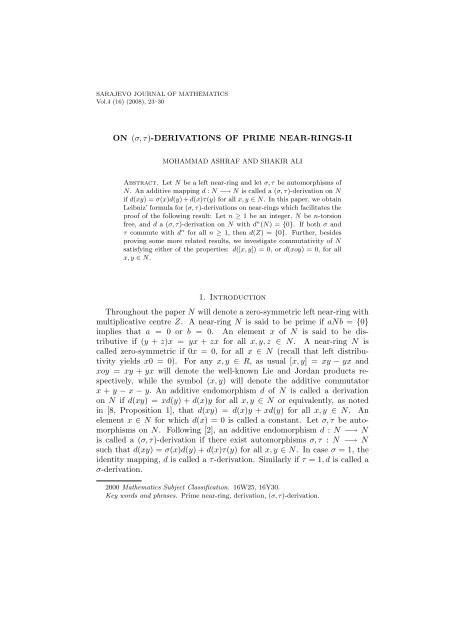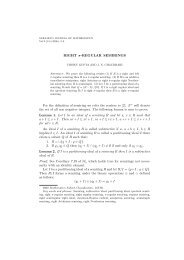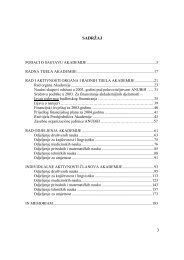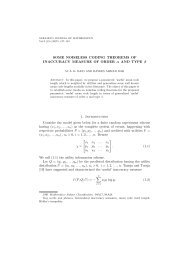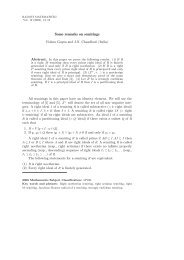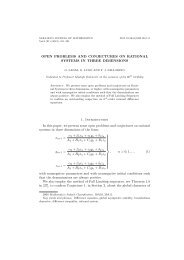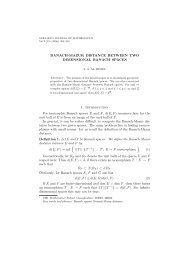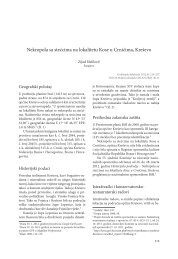Mohammad Ashraf and Shakir Ali - anubih
Mohammad Ashraf and Shakir Ali - anubih
Mohammad Ashraf and Shakir Ali - anubih
Create successful ePaper yourself
Turn your PDF publications into a flip-book with our unique Google optimized e-Paper software.
24 MOHAMMAD ASHRAF AND SHAKIR ALIThere are several results asserting that prime near-rings with certain constrainedderivations have ring-like behavior. Recently many authors havestudied commutativity of prime <strong>and</strong> semi-prime rings with derivations. Inview of these results it is natural to look for comparable results on near-rings<strong>and</strong> this has been done in [1], [2], [3], [4], [5] <strong>and</strong> [8] etc. In order to facilitateour discussion we need to extend Leibniz’ theorem for derivations innear-rings to (σ, τ)-derivations in near-rings. Though it has been obtainedin [8] for derivations in near-rings, there appears to be a torsion restrictionthat has not be used in the proof. By simple calculations, it can be easilyseen that Leibniz’ rule holds even in the case of (σ, τ)-derivations in nearrings.Besides proving Leibniz’ formula for (σ, τ)-derivations in near-rings,we extend some results due to Wang [8] <strong>and</strong> Bell [4] for (σ, τ)-derivations onnear-rings. Some new results have also been obtained for prime near-rings.Finally, it is shown that under appropriate additional hypothesis a near-ringmust be a commutative ring.2. Preliminary resultsWe begin with the following known results. The proofs of the first threecan be found in [2] while the fourth is essentially proved in [1].Lemma 2.1. ([2, Lemma 2.1]). An additive endomorphism d on a near-ringN is a (σ, τ)-derivation if <strong>and</strong> only if d(xy) = d(x)τ(y) + σ(x)d(y), for allx, y ∈ N.Lemma 2.2. ([2, Lemma 2.2]). Let d be a (σ, τ)-derivation on a near-ringN. Then N satisfies the following partial distributive laws:(i) (σ(x)d(y) + d(x)τ(y))z = σ(x)d(y)z + d(x)τ(y)z, for all x, y, z ∈ N.(ii) (d(x)τ(y) + σ(x)d(y))z = d(x)τ(y)z + σ(x)d(y)z, for all x, y, z ∈ N.Lemma 2.3. ([2, Theorem 3.1]). Let N be a prime near-ring admittinga non-trivial (σ, τ)-derivation d for which d(N) ⊆ Z. Then (N, +) isabelian. Moreover, if N is 2-torsion free <strong>and</strong> σ,τ commute with d, then Nis a commutative ring.Lemma 2.4. ([1, Proposition 2.1]). Let N be a prime near-ring. If d is a(σ, σ)-derivation on N, then d(Z) ⊆ Z.3. Main resultsThe following theorem has its independent interest in the study of (σ, τ)-derivations in near-rings. In fact Leibniz’ formula has already been obtainedby Wang [8] for derivations in near-rings. Now, we shall extend this resultfor (σ, τ)-derivations in near-rings.
26 MOHAMMAD ASHRAF AND SHAKIR ALIBy application of (3.2), the above expression yields thatd n (xy) = d(d n−1 (xy))( ) n − 1= d(d n−1 (x)τ n−1 (y) + · · · + d n−i (σ i−1 (x))d i−1 (τ n−i (y))i − 1( ) n − 1+ d n−i−1 (σ i (x))d i (τ n−i−1 (y)) + · · · + σ n−1 (x)d n−1 (y))i= d((d n−1 (x)τ n−1 (y)) + · · · +( n − 1+i( n − 1i − 1)d(d n−i (σ i−1 (x))d i−1 (τ n−i (y)))d(d n−i−1 (σ i (x))d i (τ n−i−1 (y))) + · · · + d(σ n−1 (x)d n−1 (y))for all x, y ∈ N. This implies that( ) n − 1d n (xy) = d n (x)τ n (y) + · · · + d n−i (σ i (x))d i (τ n−i (y))i − 1( ) n − 1+ d n−i (σ i (x))d i (τ n−i (y)) + · · · + σ n (x)d n (y)i[ ( ) ( )= d n (x)τ n n − 1 n − 1 ](y) + · · · + + d n−i (σ i (x))d i (τ n−i (y))i − 1 i+ · · · + σ n (x)d n (y)( ) n= d n (x)τ n (y) + · · · + d n−i (σ i (x))d i (τ n−i (y)) + · · · + σ n (x)d n (y)ifor all x, y ∈ N. Hence,d n (xy) =n∑r=0( nr)d n−r (σ r (x))d r (τ n−r (y)),for all x, y ∈ N. This completes the proof of the theorem.Corollary 3.1. ([8, Proposition 3]). Let N be a near-ring. If N admits aderivation d, then for any integer n ≥ 1 <strong>and</strong> for all x, y ∈ N, we haven∑( nd n (xy) = dr)n−r (x)d r (y)where 0 ≤ r ≤ n.r=0As an application of the above theorem we get the following results:Theorem 3.2. Let n ≥ 1 be a fixed positive integer <strong>and</strong> let N be an n-torsion free near-ring. Suppose that σ, τ are automorphisms of N <strong>and</strong> da (σ, τ)-derivation on N such that σ, τ commute with d k , for all integers□
28 MOHAMMAD ASHRAF AND SHAKIR ALIProof. In view of our hypothesis, we haveEquation (4.1) can be written as,d(xy) = d(yx), for all x, y ∈ N. (4.1)σ(x)d(y) + d(x)σ(y) = σ(y)d(x) + d(y)σ(x), for all x, y ∈ N. (4.2)Replacing x by yx in (4.2) <strong>and</strong> using (4.1), we obtain,σ(yx)d(y) + d(yx)σ(y) = σ(y)d(xy) + d(y)σ(yx), for all x, y ∈ N. (4.3)This implies thatσ(yx)d(y) + (σ(y)d(x) + d(y)σ(x))σ(y)= σ(yx)d(y) + σ(y)d(x)σ(y) + d(y)σ(yx),for all x, y ∈ N. Now, application of the Lemma 2.2 yields thatd(y)σ(x)σ(y) = d(y)σ(y)σ(x), for all x, y ∈ N. (4.4)Again replace x by xz in (4.4) <strong>and</strong> use (4.4), to getThis implies thatd(y)σ(x)σ(z)σ(y) = d(y)σ(xy)σ(z), for all x, y, z ∈ N. (4.5)d(y)σ(x)σ([y, z]) = 0, for all x, y, z ∈ N. (4.6)Since σ is an automorphism of N, we getσ −1 (d(y))N[y, z] = {0}, for all y, z ∈ N. (4.7)This yields that for each fixed y ∈ N either d(y) = 0 or [y, z] = 0, for allz ∈ N i.e., for each fixed y ∈ N, we have either d(y) = 0 or y ∈ Z. Buty ∈ Z also implies that d(y) ∈ Z, for all y ∈ N. Therefore, in both the caseswe find that d(y) ∈ Z, for all y ∈ N <strong>and</strong> hence d(N) ⊆ Z. Thus by Lemma2.3, N is a commutative ring. This completes the proof of our theorem. □Theorem 4.2. Let N be a 2-torsion free prime near-ring. Suppose d is anon-zero (σ, σ)-derivation on N such that d(xoy) = 0, for all x, y ∈ N, thenN is a commutative ring.Proof. For all x, y ∈ N, we have,that is,d(xy) = −d(yx), for all x, y ∈ N (4.8)σ(x)d(y) + d(x)σ(y) = −(σ(y)d(x) + d(y)σ(x)), for all x, y ∈ N. (4.9)Replacing x by yx in (4.9), we get,σ(yx)d(y)+d(yx)σ(y) = −(σ(y)d(yx)+d(y)σ(yx)), for all x, y ∈ N. (4.10)
ON (σ, τ)-DERIVATIONS OF PRIME NEAR-RINGS-II 29By using (4.8) <strong>and</strong> Lemma 2.2, we find thatσ(yx)d(y) + (σ(y)d(x) + d(y)σ(x))σ(y) = −(σ(y)(−d(xy)) + d(y)σ(yx))The above expression yields that= −(σ(−y)d(xy) + d(y)σ(yx))= −(−σ(y)d(xy) + d(y)σ(yx))= σ(y)(σ(x)d(y) + d(x)σ(y)) − d(y)σ(yx)= σ(y)σ(x)d(y) + σ(y)d(x)σ(y) − d(y)σ(yx).d(y)σ(x)σ(y) = −d(y)σ(yx), for all x, y ∈ N. (4.11)Again replace x by xz in (4.11) <strong>and</strong> use (4.11), we obtainThat is,d(y)σ(x)σ(z)σ(y) = d(y)σ(x)σ(y)σ(z), for all x, y, z ∈ N. (4.12)d(y)σ(x)σ([y, z]) = 0, for all x, y, z ∈ N. (4.13)Now, using the same arguments as used after equation(4.6) in the lastparagraph of the proof of Theorem 4.1, we get the required result. □Corollary 4.1. Let N be a 2-torsion free prime near-ring. Suppose thatd is a non-zero derivation on N such that d([x, y]) = 0, for all x, y ∈N or d(xoy) = 0, for all x, y ∈ N. Then N is a commutative ring.The following example demonstrates that the conclusion of the aboveresults need not be true even in the case of arbitrary rings.Example 4.1. Let R = R 1 ⊕ R 2 , where R 1 is a non-commutative ring<strong>and</strong> R 2 is a commutative domain of characteristic 2 with identity admittinga non-zero derivation δ. Define a map d : R → R such that d((a, b)) =(0, δ(b)). Then it is easy to see that d satisfies the properties: d([x, y]) =0 <strong>and</strong> d(xoy) = 0 for all x, y ∈ R. However, R is not a commutative ring.Acknowledgment. The authors are thankful to the referee for his/hervaluable comments <strong>and</strong> suggestions.References[1] M. <strong>Ashraf</strong> <strong>and</strong> <strong>Ali</strong>, <strong>Shakir</strong>, On (σ, τ)-derivations of prime near-rings, Trends inTheory of Rings <strong>and</strong> Modules, (S. Tariq Rizvi & S. M. A. Zaidi, (Eds.)), AnamayaPublishers, New Delhi, (2005), 5–10.[2] M. <strong>Ashraf</strong>, A. <strong>Ali</strong> <strong>and</strong> <strong>Ali</strong>, <strong>Shakir</strong>, (σ, τ)- derivations on prime near-rings, Arch.Math. (Brno), 40 (2004), 281–286.[3] K. I. Beidar, Y. Fong <strong>and</strong> X.K., Wang, Posner <strong>and</strong> Herstein theorems for derivationsof 3-prime near-rings , Comm. Algebra, 24 (5)(1996), 1581–1589.
30 MOHAMMAD ASHRAF AND SHAKIR ALI[4] H. E. Bell, On derivations in near-rings, II , Kluwer Academic Publishers Netherl<strong>and</strong>s(1997), 191-197.[5] H. E. Bell <strong>and</strong> G. Mason, On derivations in near-rings, Near-Rings <strong>and</strong> Near-Fields(G. Betsch, ed.) North-Holl<strong>and</strong>, Amsterdam (1987), 31–35.[6] J. D. P. Meldrum, Near-rings <strong>and</strong> their Link with Groups, Pitman, 1985.[7] E. C. Posner, Derivations in prime rings, Proc. Amer. Math. Soc., 8 (1957), 1093–1100.[8] X. K. Wang, Derivations in prime near-rings, Proc. Amer. Math. Soc., 121 (1994),361–366.(Received: December 11, 2006)(Revised: May 15, 2007)Department of Mathematics<strong>Ali</strong>garh Muslim University<strong>Ali</strong>garh-202002 (India)E–mail: mashraf80@hotmail.comshakir50@rediffmail.com


